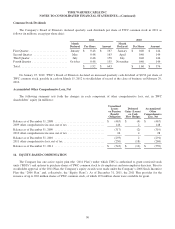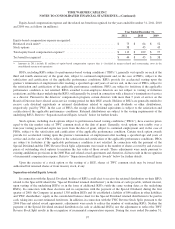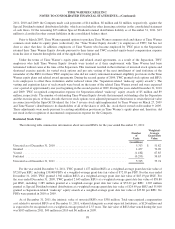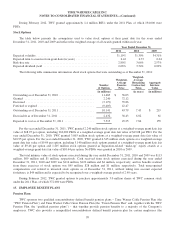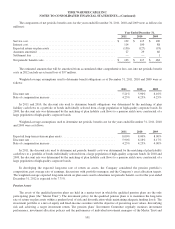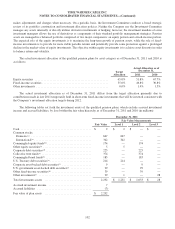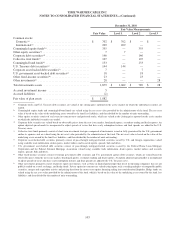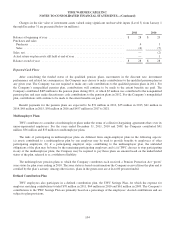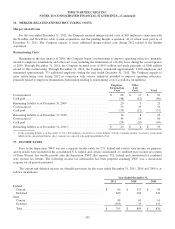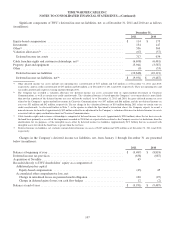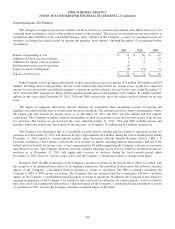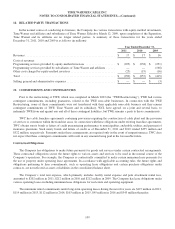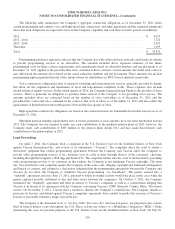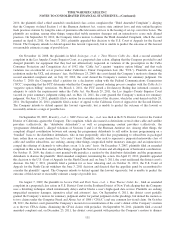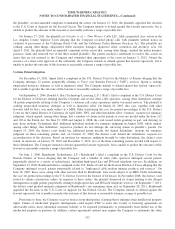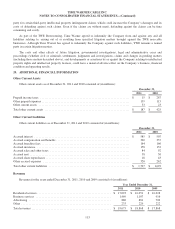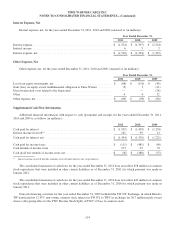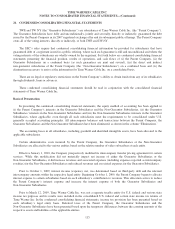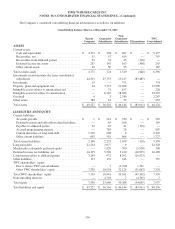Time Warner Cable 2011 Annual Report Download - page 114
Download and view the complete annual report
Please find page 114 of the 2011 Time Warner Cable annual report below. You can navigate through the pages in the report by either clicking on the pages listed below, or by using the keyword search tool below to find specific information within the annual report.
TIME WARNER CABLE INC.
NOTES TO CONSOLIDATED FINANCIAL STATEMENTS—(Continued)
The differences between income tax (benefit) provision expected at the U.S. federal statutory income tax rate of 35%
and income tax (benefit) provision provided for the years ended December 31, 2011, 2010 and 2009 are as follows (in
millions):
Year Ended December 31,
2011 2010 2009
Tax provision on income at U.S. federal statutory rate .................. $ 862 $ 769 $ 669
State and local taxes (tax benefits), net of federal tax effects ............. (76) 66 126
Equity-based compensation ....................................... 12 61 1
Other ......................................................... (3) (13) 24
Total ......................................................... $ 795 $ 883 $ 820
During the fourth quarter of 2011, TWC completed its income tax returns for the 2010 taxable year, its first full-year
income tax returns subsequent to the Separation from Time Warner, reflecting the income tax positions and state income tax
apportionments of TWC as a standalone taxpayer. Based on these returns, the Company concluded that an approximate 65
basis point change in the estimate of the effective tax rate applied to calculate its net deferred income tax liability was
required. As a result, TWC recorded a noncash income tax benefit of $178 million during the fourth quarter of 2011.
Additionally, the income tax provisions and the effective tax rates for the years ended December 31, 2011 and 2010
were impacted by net charges of $14 million ($12 million for federal taxes and $2 million for state taxes) and $68 million
($61 million for federal taxes and $7 million for state taxes), respectively, which related to the reversal of deferred income
tax assets associated with Time Warner stock option awards held by TWC employees of $58 million and $80 million,
respectively, net of excess tax benefits realized upon the exercise of TWC stock options or vesting of TWC RSUs of $44
million and $12 million, respectively. As a result of the Separation, on March 12, 2009, TWC employees who held stock
option awards under Time Warner equity plans were treated as if their employment with Time Warner had been terminated
without cause. In most cases, this treatment resulted in shortened exercise periods for vested awards, generally one year from
the date of the Separation; however, certain awards expire over a five-year period from the date of the Separation. Deferred
income tax assets were established based on the Time Warner awards’ fair values, and a corresponding benefit to the
Company’s income tax provision was recognized over the awards’ service periods. For unexercised awards that expired “out
of the money,” the fair value was $0 and the Company received no tax deduction in connection with these awards. As a
result, the previously-recognized deferred income tax assets were written off through noncash charges to income tax expense
during the periods in which the awards expired. As noted above, the charges were reduced by excess tax benefits realized
upon the exercise of TWC stock options or vesting of TWC RSUs in the same year in which the charge was taken.
106


